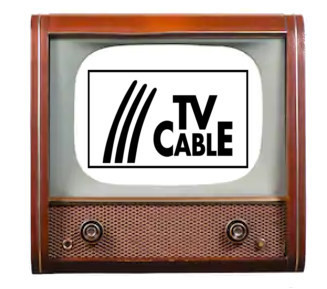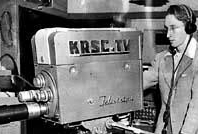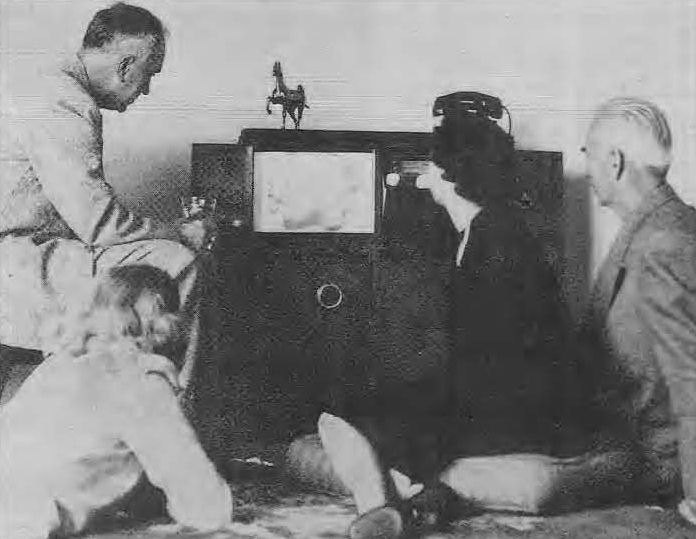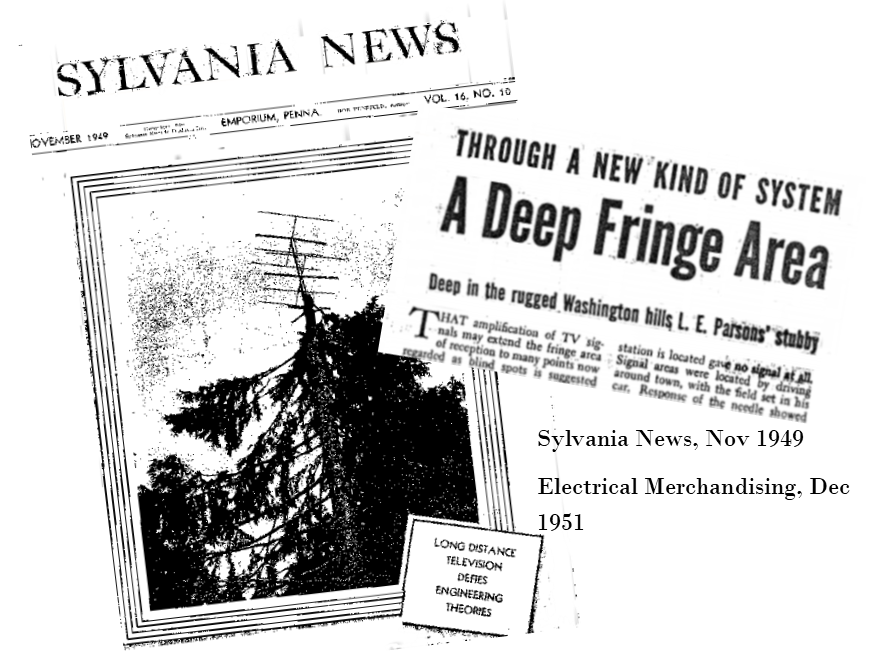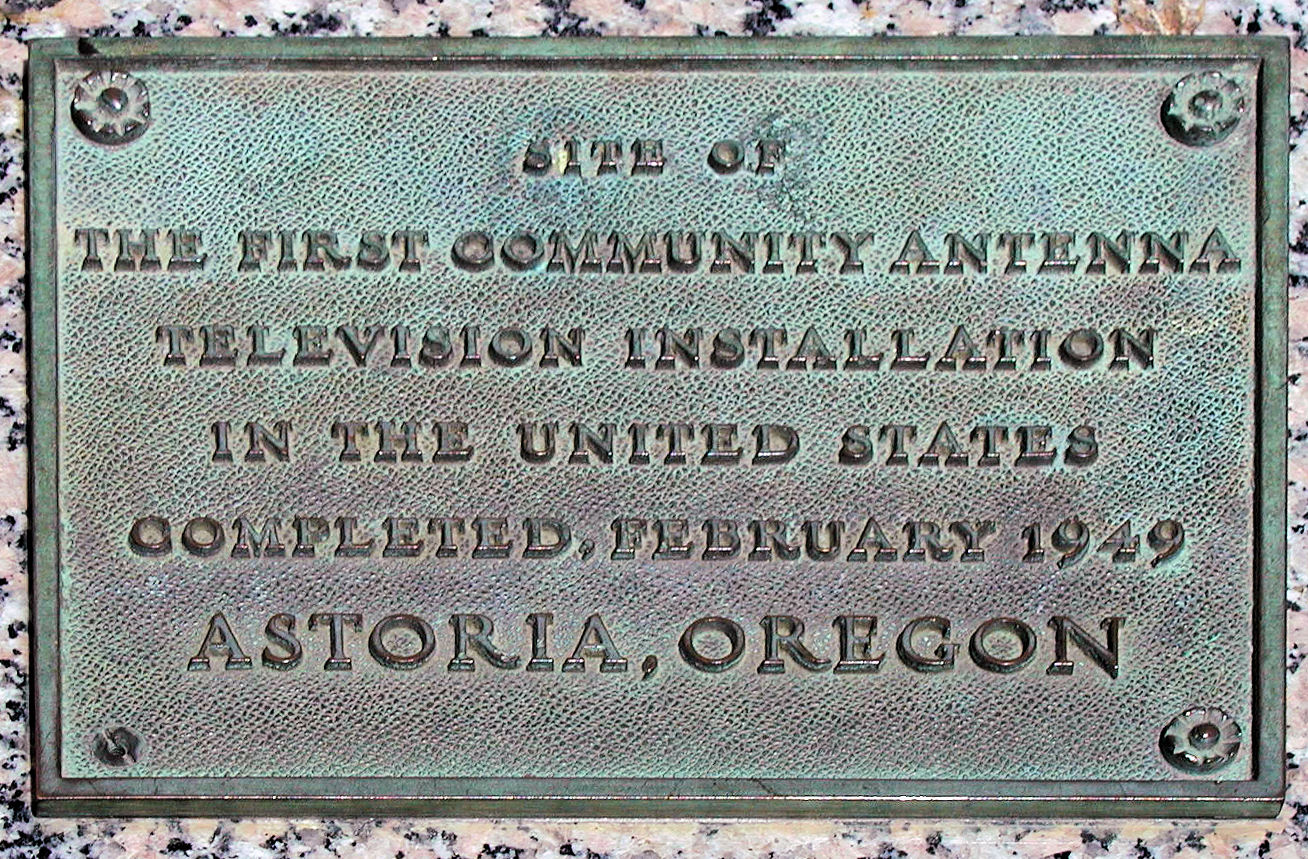In post-World War 2 the consumer economy came roaring back
and Americans had the money to purchase discretionary items
like television sets. The TV industry had been stopped cold by
the war but broadcasters were newly able to invest cash in
launching TV stations. The problem, however, was that the
Federal Communications Commission (FCC) was flooded with
applications to build new TV stations and it seemed that all
available TV channel allocations would be exhausted before
anyone to determine that their geographic distributions served
the nation broadly. Thus, in 1948 the FCC imposed a freeze on
new TV station applications while it considered the problem
(which ultimately resulted in the establishment of the UHF band of channels 14-83 when the freeze
was listed in 1952).
The eastern US had more operating TV stations in 1948 but the western US had few and the only TV
station in the Pacific Northwest was Seattle’s KRSB-TV (which later became KING-TV).
Switch to the Oregon coastal town of Astoria, which was named for John
Jacob Astor who had made a fortune in the fur trade in the early 19th century
and, as part of developing his business, has sent parties to the vicinity to
establish Fort Astoria. While his business and the fort later disappeared, the
community took its name from that heritage. In Astoria, Leroy “Ed” Parsons
was the owner of the community’s only radio station, KAST.
Parsons, accompanied by his wife Grace, attended the National Association of
Broadcasters annual convention in Chicago where television was being
demonstrated.
In Parson's words, "My wife first saw a television demonstration in the basement of the convention
hotel. She informed me on the way home that she wanted a television. I explained that the only
television station was in Chicago; there was no station on the west coast. Television reception was
physically impossible. Television stations started to develop across the United States and at the
convention the following year, it was announced that there was to be a television station built in
Seattle by KRSC. She said, "Now I can have television."
Parsons tried to explain that wasn’t a simple matter, that Seattle was too far away for a signal to
reach Astoria, but his wife was adamant. “I want pictures with our radio,” she said. Because
Parsons was a technology kind of guy, and known as very inventive, she told him that if anybody
could solve that problem she knew that he could – and so he was commissioned to grant her wish.
Parsons ordered a 9” Howard TV set, which included a radio and phonograph, and had it shipped to
Astoria. It cost over $1,000 (“and we weren’t that flush. She had to do without other things to
have the set.”) and he considered it a wasteful expense in his view primarily purchased it for its
radio and phonograph component – and only the possibility of being able to use the TV side. Grace
was really determined to have television.
The Parsons lived at the top of a 2-story building in the center of
Astoria, directly across the street from the city’s tallest building the
Astor Hotel and Parsons coincidentally had a friend, Bob Priebe, was
the manager of the Seattle KRSC, Channel 5, that was then under
construction. Parsons arranged for Priebe to keep him apprized of the
time test broadcasts were to be conducted, and working closely with
KAST’s chief engineer, Jimmy Titus, Parsons checked KRSC’s signal throughout Clatsop County by
listening to its audio signal. Sometimes he used his own airplane to cover more ground. Eventually,
he concluded that an adequate signal was available on the roof of the elegant Hotel Astoria,
located on Commercial Street across from the Parsons’ penthouse apartment.
In Parsons’ words: “Throughout the summer of '48 I had pretty high phone bills in conversing with
Bob Priebe but I was able [find] a usable signal up on the top of the Astoria Hotel and got
permission to…put an antenna up there. With the initial installation, I picked the signal up on
Channel 5 and transferred it to Channel 2 for transmission across the street to my penthouse.”
Thus, with his primitive efforts bearing success, when KRSC
signed-on November 25, 1948, Ed and Grace Parsons were watching
in their Astoria apartment (photo left). Word spread that the
Parsons had television. For the next month, people converged on
the Parsons’ apartment to watch the marvel, something that Parsons
hadn’t anticipated. Ed Parsons later recalled “We literally lost our
home. People would drive for hundreds of miles to see television.
And when people drove down from Portland or came from The
Dalles or from Klamath Falls to see television, you couldn’t tell them no.” With his home life in
chaos, Parsons ultimately ejected all of his visitors—reportedly on Christmas Eve 1948—and
confronted the realization that he had to figure out how to provide TV to others in order to
preserve his own domestic tranquility. Puzzling about how to secure, amplify and deliver a TV
signal, he suggested to the Hotel Astoria’s manager that placing a TV in the lobby might prove good
for business. Securing consent, he ran a line from his equipment located on the hotel’s roof to the
lobby, where he set up a receiver. The Hotel Astoria’s lobby became “a theater every night with
two rows of chairs and divans drawn up before the 12-inch television screen,” he recalled. Soon,
the TV traffic became too much even for the hotel, so Parsons next ran a wire across the street to
Cliff Poole’s music store. There, even more Astorians could watch television on a receiver placed
in the store’s display window. Poole’s Music Store had become the first official cable television
customer in the nation. The attraction quickly drew crowds, causing the police to complain over
the impediment to street traffic.
Clearly, Parsons needed to establish more TV viewing locations, so beginning in February 1949, he
started running coaxial cables through downtown Astoria.9 Over the next three months, wires were
plumbed through elevator shafts and underground tunnels, across buildings and along utility
poles—all terminating in residences, taverns and businesses where TV could then be seen. One of
Parsons’ customers was the Elks Club, which set up a television set and published a schedule of
programs. Group viewing was possible at the Elks Club, although reserved solely for members, and
that location helped relieve some of the pressure on other viewing locations in town.
Responding to requests from friends that he “hook them up,” Parsons had about 25 subscribing
neighbors by the summer of 1949. Parsons treated the cables as common property of the “system,”
in which all the customers were essentially participants in a cooperative. Although the financial
arrangements were neither permanent nor precise, everyone connected to the system had become
Parsons’ cable customers. While not entirely certain that it was necessary to secure KRSC’s
permission to distribute its signal in this way, Parsons nevertheless requested such authority as a
precautionary step—because cable subscriptions were growing. In a letter dated May 18, 1949, KRSC
manager Priebe authorized Parsons to relay KRSC’s signal to his subscribers.
DEVEOPING THE ASTORIA CABLE TELEVISION SYSTEM
Parsons’ system was primitive and suffered from bugs that required time and money to resolve. At
one point, he brought a friend, Tom Becker, into the venture. Becker recalled: “I raised $50,000
and spent three months trying to get the cable reception to work. At the end of 3 months, I gave
back all of the $50,000 to the friends of mine that had invested. The problem was herringbone in
the TV and we could not get the picture clear. We later found out that the cable was not uniform
and the line amplifiers were not uniform. I got out of cable TV but got several others in the
business that stuck with it and made millions.”
By May 1950, Parsons had sufficiently resolved the technical
problems to begin operating on a commercial basis as the Pacific
Television Company. He had 150 subscribers. News reports about
the Astoria system began producing inquiries from across America,
and Parsons established a consulting business with Byron E. Roman
to offer consulting services on community
antenna television installations, as well as
sell associated equipment. The company
helped design and construct numerous
cable television systems, including installations in Aberdeen/Hoquiem and
Centralia, Washington, and Lewiston, Idaho.
News of these installations began to filter across the country producing a
great deal of newspaper and magazine coverage – which only served to fuel
interest across the country.
PARSONS INVENTS THE TV TRANSLATOR
Parsons’ initial cable TV approach had been to carefully locate a master antenna, boost the signal it
received and then redistribute it by wire. Since wires were hard to run in some locations, he
eventually constructed a device to receive KRSC’s channel 5 signal on-air and retransmit it on
channel 2 to receivers throughout Astoria. Parsons installed the device without notifying the FCC,
and for the time being both he and the commission more or less mutually ducked the issue of
whether his unit required a license. Parsons had designed and built the first television translator, a
device that eventually became critically important in extending television—and later FM—signals to
distant communities.
PARSONS LEAVES THE ASTORIA CABLE SYSTEM BEHIND
In the beginning, no one really questioned whether Parsons had the authority to run wires around
Astoria just as no one questioned whether his translator required a license. But later, the City of
Astoria was anything but clear about the propriety of the cable installation. After considerable legal
wrangling, Pacific Television was ultimately granted a city franchise to make “pole attachments”
to Astoria’s utility poles. All of these matters—the debugging of the Astoria installation, the
municipal franchise negotiations and the explosive growth of the cable installation consulting
business—took their toll. In March 1953, Parsons collapsed and was hospitalized with exhaustion. His
doctors ordered him to rest completely for a full 30 days, and ultimately were only willing to
release him from the hospital if he was removed from the community for 30 days to a place where
he could have total rest. The plan was for him to go to Grace’s mother – but he changed his
mind, got into his airplane and went to Alaska. He never returned to Astoria.
While Mahanoy City, Pennsylvania vies with Astoria
for recognition as the founding location of the cable
TV industry, Astoria’s claim was recognized by the
National Cable Television Association (NCTA) in 1968
when it installed a monument at the base of the
famed Astor Column on Coxcomb Hill (where Parsons
had located one of his system’s receiving antennas).
Its inscription reads: “Site of the first community
antenna television installation in the United States
completed February 1949 Astoria, Oregon. Cable
television was invented and developed by L. E. (Ed)
Parsons on Thanksgiving Day, 1948. The system carried the first TV transmission by KRSCTV Channel
5, Seattle. This marked the beginning of Cable TV.”


